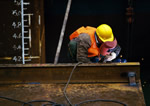If you are in the business of oil and gas you need to know that OSHA’s got a long list of standards just for you–and this includes training requirements. Because of the specific hazards involved with the oil and gas industry there are many areas you’ve got to cover with your workers. Here are the biggies.
Personnel Protective Equipment

General safety precautions include wearing required personal protective equipment (PPE), such as hard hats, hearing and eye protection, work gloves, and safety shoes. Respirators are required when hazardous levels of gases or vapors are present. In addition, your workers must take these steps to avoid slip, trip, and fall hazards:
- Use waterproof footgear to decrease slip/fall hazards.
- Keep work areas and walkways clean and clear of oil, tools, debris, and other trip hazards.
- Make sure required guardrails and guards are in place and open cellars are covered.
- Select only ladders in good condition, and use and install them safely.
- Keep all cords and hoses orderly and clear of walking spaces.
- Conduct a pre-job inspection to identify and correct hazardous walking surfaces.
Need an answer fast? Relax. Our editors guarantee a personalized response to your questions within 3 business days. Take a free trial of Enviro.BLR.com and see what everyone is talking about. For a limited time, also receive the new free special report: 2011-2012 EHS Salary Guide. Download Your Free Report
Lifting Safely
To avoid strains and sprains in oil and gas operations, instruct employees to:
- Use proper lifting techniques, positioning hands and body properly for a safe lift.
- Hoist slowly to limit pipe momentum.
- Seek assistance when moving awkward and heavy guards, covers, and other items.
- Use proper stance and drill pipe slip-lifting techniques. Slips have three handles and should be lifted jointly by more than one person.
- Use lifting equipment and limit manual positioning of elevators.
- Practice proper hand placement and use of pullback (tail) ropes.
Hydrogen Sulfide
Train your employees to recognize hydrogen sulfide hazards by giving them the following information:
- Hydrogen sulfide is a flammable, colorless gas that is toxic at extremely low concentrations.
- It is heavier than air and may accumulate in low-lying or enclosed areas, such as a gas venting system, mud system, cellars, pits, and tanks.
- It has a “rotten egg” smell at low concentrations and quickly causes you to lose sense of smell.
- Iron sulfide, a by-product of many production operations, may spontaneously combust with air.
- Flaring operations associated with hydrogen sulfide production generate toxic sulfur dioxide.
- The danger is increased in confined spaces, which must be tested, adequately ventilated, and monitored, and respirators worn if concentrations of gas are above permissible exposure levels.
Among other safety requirements, your employees must be able to:
- Identify the characteristics, sources, and hazards of hydrogen sulfide.
- Use detection and ventilation methods properly.
- Recognize symptoms of exposure and understand proper rescue techniques and first aid.
- Recognize warnings established by the American Petroleum Institute (API):
- API condition I: low hazard—work locations where atmospheric concentrations of hydrogen sulfide are less than 10 parts per million (ppm) (green warning flag);
- API condition II: medium hazard—work locations where atmospheric concentrations of hydrogen sulfide are greater than 10 ppm and less than 30 ppm (yellow warning flag); and
- API condition III: high hazard—work locations where atmospheric concentrations of hydrogen sulfide are greater than 30 ppm (red warning flag).
Forget expensive calls to lawyers and consultants. With Enviro.BLR.com, you get instant access, 24/7. Try it out today and get the 2011-2012 EHS Salary Guide, absolutely free. Download Your Free Report
Hot Work

Finally, train employees to perform hot work safely by taking these precautions:
- Inspect the work area to ensure that all fuel and ignition sources are isolated by shielding, clearing the area, performing lockout/tagout, or soaking flammable material with water.
- Wear appropriate PPE, such as a face shield, leather welder’s vest, and gauntlet gloves.
- Use cotton or denim clothing, and use UV shielding for arc welding where practical.
- Inspect welding and cutting equipment before use, and leak test gas torches, gauges, and hoses.
- Review the hot work permit, if available, and ensure adequate ventilation.
- Do not perform hot work where flammable vapors or combustible materials exist.
- Make suitable fire-extinguishing equipment immediately available.
- Fire watchers are required whenever welding or cutting is performed in locations where anything greater than a minor fire might develop.
- Store gas cylinders properly in a well-ventilated area away from ignition sources.
- Remove gauges and regulators, and install valve caps before transporting.
